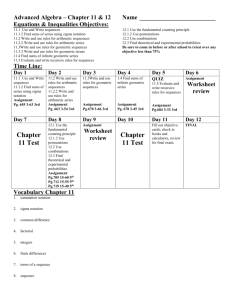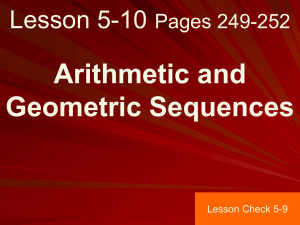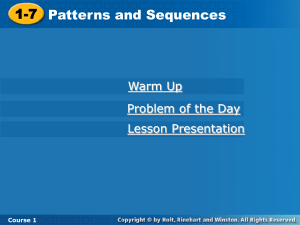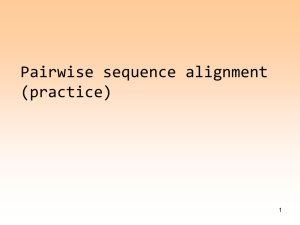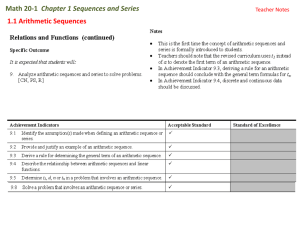Level 2 Mathematics and Statistics internal
advertisement
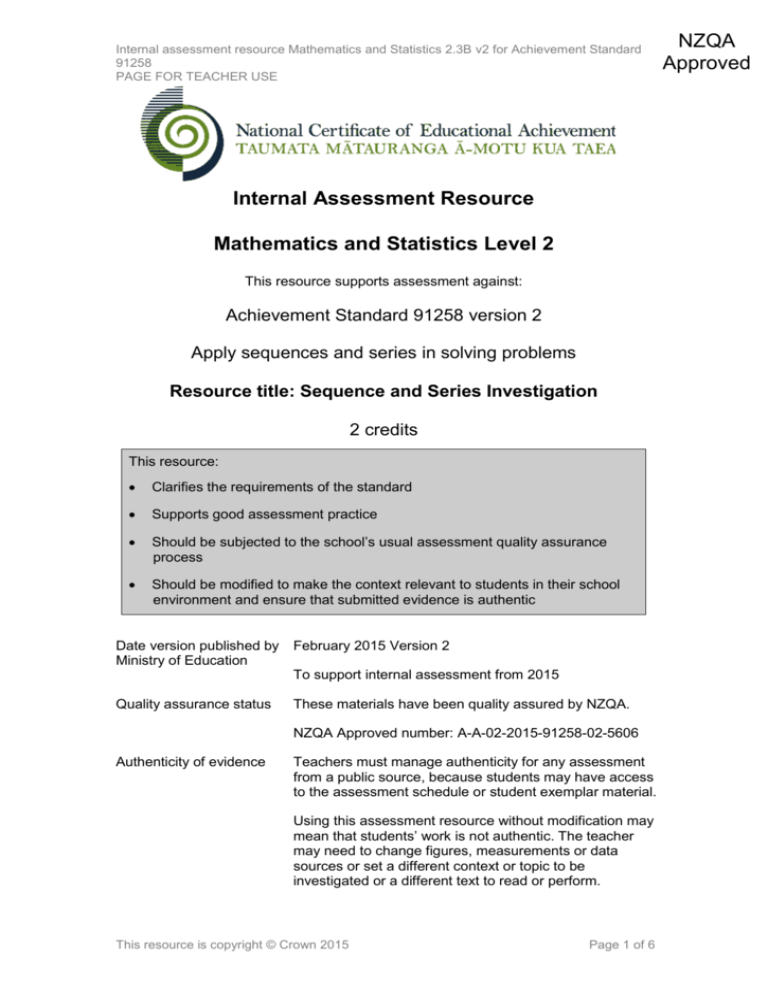
Internal assessment resource Mathematics and Statistics 2.3B v2 for Achievement Standard 91258 PAGE FOR TEACHER USE Internal Assessment Resource Mathematics and Statistics Level 2 This resource supports assessment against: Achievement Standard 91258 version 2 Apply sequences and series in solving problems Resource title: Sequence and Series Investigation 2 credits This resource: Clarifies the requirements of the standard Supports good assessment practice Should be subjected to the school’s usual assessment quality assurance process Should be modified to make the context relevant to students in their school environment and ensure that submitted evidence is authentic Date version published by Ministry of Education February 2015 Version 2 To support internal assessment from 2015 Quality assurance status These materials have been quality assured by NZQA. NZQA Approved number: A-A-02-2015-91258-02-5606 Authenticity of evidence Teachers must manage authenticity for any assessment from a public source, because students may have access to the assessment schedule or student exemplar material. Using this assessment resource without modification may mean that students’ work is not authentic. The teacher may need to change figures, measurements or data sources or set a different context or topic to be investigated or a different text to read or perform. This resource is copyright © Crown 2015 Page 1 of 6 NZQA Approved Internal assessment resource Mathematics and Statistics 2.3B v2 for Achievement Standard 91258 PAGE FOR TEACHER USE Internal Assessment Resource Achievement Standard Mathematics and Statistics 91258: Apply sequences and series in solving problems Resource reference: Mathematics and Statistics 2.3B v2 Resource title: Sequences and Series Investigation Credits: 2 Teacher guidelines The following guidelines are designed to ensure that teachers can carry out valid and consistent assessment using this internal assessment resource. Teachers need to be very familiar with the outcome being assessed by Achievement Standard Mathematics and Statistics 91258. The achievement criteria and the explanatory notes contain information, definitions, and requirements that are crucial when interpreting the standard and assessing students against it. Context/setting The intention of this assessment activity is for students to investigate a situation that uses sequences and series. The situation may be one found by students. Alternatively, provide a number of situations (relevant to students in your school) for students to select from. The situation needs to provide the opportunity for students to demonstrate the requirements of the standard. Check the task carefully to ensure that it is consistent with the situation(s) chosen and adapt it as required to suit the situation. In addition, the assessment schedule would need to be aligned with the task in its final form. An example of a context has been provided (saving to buy a car). Modify the context as needed. Examples of situations that involve arithmetic sequences and series are: table mortgages, mathematical patterns, patterns in nature, tiling patterns, and hire purchase payments. Examples of situations that involve geometric sequences and series are: loan repayments, population predictions, car depreciation, half-life of radioactive material, saving money, and hire purchase payments. Conditions This assessment activity may be conducted in one or more sessions. Confirm the timeframe with your students as appropriate for the selected context(s). Students need to work independently. Students may use graphing calculators, computer spreadsheets, or similar technology. This resource is copyright © Crown 2015 Page 2 of 6 Internal assessment resource Mathematics and Statistics 2.3B v2 for Achievement Standard 91258 PAGE FOR TEACHER USE Resource requirements Provide students with copies of the Level 2 Mathematics formulae sheet. Additional information Teachers need to customise the schedule with examples of expected student evidence at each achievement level for the particular context that the students use. This resource is copyright © Crown 2015 Page 3 of 6 Internal assessment resource Mathematics and Statistics 2.3B v2 for Achievement Standard 91258 PAGE FOR STUDENT USE Internal Assessment Resource Achievement Standard Mathematics and Statistics 91258: Apply sequences and series in solving problems Resource reference: Mathematics and Statistics 2.3B v2 Resource title: Sequences and Series Investigation Credits: 2 Achievement Apply sequences and series in solving problems. Achievement with Merit Achievement with Excellence Apply sequences and series, using relational thinking, in solving problems. Apply sequences and series, using extended abstract thinking, in solving problems. Student instructions Introduction Sequences and series arise in many real life situations, for example, saving money, population predictions, car depreciation, half-life of radioactive material, or hire purchase repayments. This assessment activity requires you to find and investigate a real life situation that can be modelled with sequences and series. For example, you could explore the financial commitments around buying a car by investigating savings deposit interest rates, loan repayment options, and hire purchase costs. Task Find and investigate a real life situation that can be modelled by arithmetic and geometric sequences and series. Your chosen situation must involve the use of both arithmetic and geometric sequences and series. You are expected to: describe the situation explain which aspects of the situation can be modelled using arithmetic and geometric sequences and series use the mathematics of sequences and series to find at least three values for each type of sequence (this needs to include general terms of sequences and partial sums of sequences) model the situation using formulae make and justify an appropriate comparison or recommendation related to the situation. This resource is copyright © Crown 2015 Page 4 of 6 Internal assessment resource Mathematics and Statistics 2.3B v2 for Achievement Standard 91258 PAGE FOR STUDENT USE The quality of your reasoning, the range of methods used, and how well you link your context to generalisations of arithmetic and geometric sequences will determine the overall grade. Clearly show all your calculations and communicate your method using appropriate mathematical statements. This resource is copyright © Crown 2015 Page 5 of 6 Internal assessment resource Mathematics and Statistics 2.3B v2 for Achievement Standard 91258 PAGE FOR TEACHER USE Assessment schedule: Mathematics and Statistics 91258 Sequences and Series Investigation Teacher note: Teachers will need to customise this schedule with examples of the types of responses that can be expected based on the actual task students do. Evidence/Judgements for Achievement Evidence/Judgements for Achievement with Merit The student has applied sequences and series methods in solving problems. The student has applied sequences and series methods, demonstrating relational thinking in solving problems. The student correctly selects and uses sequences and series. They have demonstrated knowledge of concepts and terms and communicated using appropriate representations. The student has related their findings to the context or communicated their thinking using appropriate mathematical statements. The student uses the contextual information to find general terms and partial sums that are relevant to the investigation of the situation. The student connects the contextual information to form appropriate models and uses them to calculate terms and/or sums to investigate the situation. For example, a student might: For example, a student might: use the model for the general term of a geometric sequence to calculate a specific term(s) find a specific partial sum of a geometric sequence use the model for the partial sum of a geometric sequence to calculate a specific partial sum(s). find a specific term of an arithmetic sequence use the model for the general term of an arithmetic sequence to calculate a specific term(s) use the model for the partial sum of an arithmetic sequence to calculate a specific partial sum(s). use the appropriate model to calculate a sum to infinity. find a specific term of a geometric sequence find a specific partial sum of an arithmetic sequence. Evidence/Judgements for Achievement with Excellence The student has applied sequences and series methods, demonstrating extended abstract thinking in solving problems. The student has used correct mathematical statements or communicated mathematical insight. The student devises a strategy to investigate the situation. This will include forming a generalisation for the sequences that model the situation and using the generalisations to make an appropriate conclusion. The calculations enable an appropriate conclusion to be made. Final grades will be decided using professional judgement based on a holistic examination of the evidence provided against the criteria in the Achievement Standard. This resource is copyright © Crown 2015 Page 6 of 6



